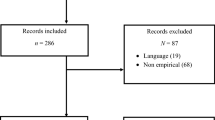Abstract
To find prevalence of noise induced hearing loss (NIHL) among auto drivers in central Bangalore using a structured questionnaire and audiometric evaluation. To establish a relation between age and duration of work to the presence of noise induced hearing loss among the autorickshaw drivers. To assess the validity of the questionnaire as a screening tool.A cross sectional study conducted in VV Puram, Bangalore from April–August 2019. 100 autorickshaw drivers were subjected to Pure tone audiometry (PTA) evaluation and were asked to answer a self-structured questionnaire comprising of 9 questions. Each question was scored from 0 to 3, making 27 the maximum score a person could obtain. Based on the score they were categorised as mild (6–10), moderate (10–20) and severe (> 20) hearing loss. Any dip found in the bone conduction in the audiometry at higher frequencies was labelled as presence of NIHL. Age and duration of working hours were noted in order to establish the relation of the two with the presence of noise induced hearing loss.The prevalence of NIHL among the study samples was found to be 40% based on the questionnaire and audiometry test combined. The questionnaire showed a sensitivity of 80% reflecting that it is an efficient tool for screening NIHL among the auto drivers. Prevelance of NIHL was found to be higher among older and study groups with longer working hours. Though majority of the auto drivers did not complain of a hearing loss, a structured questionnaire combined with a pure tone audiometric evaluation helped in identification of early changes of NIHL.




Similar content being viewed by others
References
Taneja MK (2014) Noise-induced hearing loss. Indian J Otol 20:151–154
Estimates [Internet]. World Health Organization. 2019. https://www.who.int/deafness/estimates/en/. 6 Nov 2019
Nandi SS, Dhatrak SV (2008) Occupational noise-induced hearing loss in India. Indian J Occup Environ Med 12(2):53–56. https://doi.org/10.4103/0019-5278.43260
Bare Acts in India - statutes and laws free download… [Internet]. http://www.legalserviceindia.com/issues/feed-rss-topic1458.xml. 6 Nov 2019
Le TN, Straatman LV, Lea J, Westerberg B (2017) Current insights in noise-induced hearing loss: a literature review of the underlying mechanism, pathophysiology, asymmetry, and management options. J Otolaryngol Head Neck Surg 46(1):41. https://doi.org/10.1186/s40463-017-0219-x
Population of Bangalore 2019 | India Population 2019 [Internet]. Indiapopulation2019.com. 2019. https://indiapopulation2019.com/population-of-bangalore-2019.html. 13 Dec 2019
Talati V, Talati A (2016) Noise pollution at selected junctions of Vadodara City from vehicular traffic. Int J Innov Res Sci Eng Technol 5(4):5533–5539
India - total number of vehicles in Karnataka 2016 | Statista [Internet]. Statista. 2019. https://www.statista.com/statistics/665558/total-number-of-vehicles-in-karnataka-india/. 13 Dec 2019
D L J. Exposure criteria, occupational exposure level [Internet]. Who.int. 2019. https://www.who.int/occupational_health/publications/noise4.pdf. 13 Dec 2019
Alberti P (1987) Scott Brown’s otorhinolaryngology, adult audiology, 5th edn. Butterworth & Co., Paddington, pp 594–612
Rabinowitz P, Galusha D, Slade M, Dixon-Ernst C, Sircar K, Dobie R (2006) Audiogram notches in noise-exposed workers. Ear Hear 27(6):742–750
Majumder J, Mehta CR, Sen D (2009) Excess risk estimates of hearing impairment of Indian professional drivers. Int J Ind Ergon 39(1):234–238
Ralli M, Balla MP, Greco A et al (2017) Work-related noise exposure in a cohort of patients with chronic tinnitus: analysis of demographic and audiological characteristics. Int J Environ Res Public Health 14(9):1035
Merchant AT, Lalani I, Afridi ZH, Latif N, Malik TA, Merchant SS et al (2000) What is the effect of riskshaw noise on its driver? J Pak Med Assoc 50(4):124–128
Gathe BM, Gandhe MB, Sahu B, Gosewade N, Saraf CA, Singh R (2016) Effect of noise pollution on hearing in auto-rickshaw drivers: a brainstem auditory-evoked potentials study. Indian J Otol 22:275–279
Saxena A (2018) Noise induced hearing loss in Indian railway loco pilots: are we aware? Otolaryngol Open J 4(2):18–21
Pop P, Uthaiah N (2019) Noise Pollution from Vehicular Traffic from Selected Junctions in Bengaluru [Internet]. Engineeringcivil.com. https://www.engineeringcivil.com/noise-pollution-from-vehicular-traffic-from-selected-junctions-in-bengaluru.html
McCombe A, Baguley D (2019) Scott brown”s otorhinolaryngology, head and neck surgery, vol 2. CRC Press, Boca Raton, pp 701–710
Acknowledgements
Nil.
Funding
Nil.
Author information
Authors and Affiliations
Corresponding author
Ethics declarations
Conflict of interest
None.
Ethical Standards
The authors assert that all the procedures contributing to this work comply with ethical standards of the relevant national and institutional guidelines on human experimentation and with the Helsinki declaration of 1975, as revised in 2008. Informed consent was obtained before enrolling the subjects for the study.
Additional information
Publisher's Note
Springer Nature remains neutral with regard to jurisdictional claims in published maps and institutional affiliations.
Rights and permissions
About this article
Cite this article
Anil, H.T., Arunima, S. Noise Induced Hearing Loss in Autorickshaw Drivers in Bangalore: A Cross Sectional Study. Indian J Otolaryngol Head Neck Surg 74 (Suppl 1), 93–99 (2022). https://doi.org/10.1007/s12070-020-01829-6
Received:
Accepted:
Published:
Issue Date:
DOI: https://doi.org/10.1007/s12070-020-01829-6




